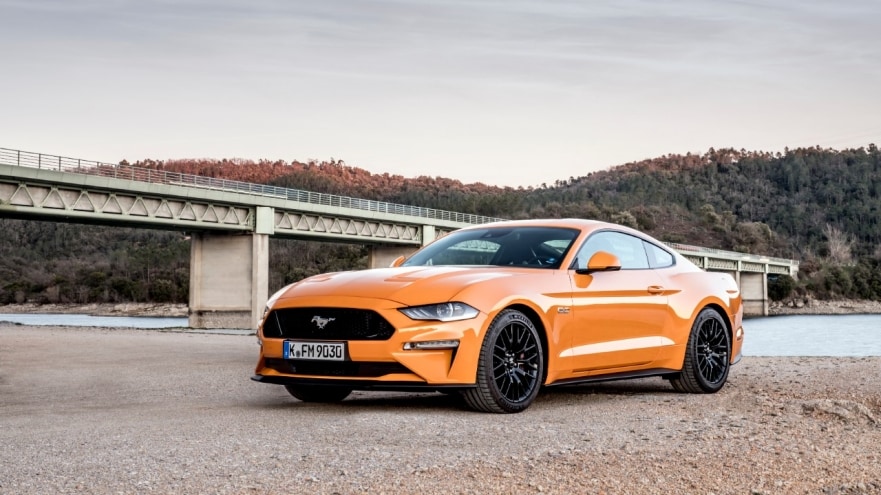Ford sold 13,100 Mustangs in Europe in 2017, and 35,000 since introducing the iconic car to Europe in 2015. New Mustang and special edition Mustang BULLITT on sale later this year
COLOGNE, Germany, April 17, 2018 – Global demand for the new 2018 Ford Mustang has driven Mustang to its third straight year as the best-selling sports coupe in the world.
Global Mustang registrations in 2017 totalled 125,809 cars, according to Ford analysis of the most recent new light vehicle registration data from IHS Markit. This data – compiled from government and other sources and capturing 95 per cent of global new vehicle volumes in more than 80 countries – puts Mustang ahead of all other sports coupe competitors worldwide.
“The world is falling in love with Mustang,” says Erich Merkle, Ford sales analyst. “Mustang represents the best of American design, performance and freedom, with an unmistakable personality that’s appeals – regardless of your post code.”
Of the nearly 126,000 vehicles registered worldwide, Ford reported 81,866 of those were registered in the United States where Mustang is manufactured, meaning just over one-third of all Mustang registrations are occurring in export markets.
Ford sold 13,100 Mustangs in Europe last year according to the company’s own data,* and outsold the Porsche 911 in 13 European markets, including the U.K. and Spain. The leading five European markets for Mustang sales in 2017 were Germany (5,742), the U.K. (2,211), France (942), Belgium (900), and Sweden (512).
Demand also remains particularly strong in China, where Mustang was the best-selling sports coupe last year based on 7,125 registrations.
Since global exports began in 2015, through December 2017, Ford has sold 418,000 Mustangs around the world. The most popular configuration worldwide is the Mustang GT with the 5.0-litre V8.
Ford has sold 35,000 Mustangs in Europe since 2015 through March 2018,* and later this year introduces the new Ford Mustang featuring a more athletic exterior, and an upscale interior with soft-touch materials and 12-inch digital instrument cluster. Enhanced powertrains include Ford's 450 PS 5.0-litre V8 and 10-speed automatic transmission for 0-100 km/h (0-62 mph) acceleration in 4.3 seconds, 12.1 l/100 km fuel efficiency and 270 g/km CO2.**
Advanced driving technologies include MagneRide® adjustable suspension, selectable Drive Modes and a new Active Valve Performance Exhaust that delivers an innovative Good Neighbour Mode for early-morning or late-night driving. New driver assistance technologies include Pre-Collision Assist with Pedestrian Detection and Lane Keeping Aid.
In addition, a special edition Ford Mustang Bullitt celebrating the famous film’s 50th anniversary begins production for Europe in June.
Available in Shadow Black or classic Dark Highland Green, Mustang Bullitt is powered by an uprated 5.0-litre V8 engine that will deliver an anticipated 464 PS and 529 Nm of torque.*** New rev-matching technology will deliver smooth, seamless gear-changes accompanied by a sporty V8 “blip” during six-speed manual transmission downshifts. A standard B&O PLAY premium audio system will deliver 1000 watts of power through 12-high performance speakers.
Sports coupes, as defined by IHS Markit, include two-door and convertible models.
# # #
MagneRide is a trademark of BWI Group
*The Euro 20 markets are: Austria, Belgium, Britain, Czech Republic, Denmark, Finland, France, Germany, Greece, Hungary, Ireland, Italy, Netherlands, Norway, Poland, Portugal, Spain, Romania, Sweden and Switzerland.
**The declared Fuel/Energy Consumptions, CO2 emissions and electric range are measured according to the technical requirements and specifications of the European Regulations (EC) 715/2007 and (EC) 692/2008 as last amended. Fuel consumption and CO2 emissions are specified for a vehicle variant and not for a single car. The applied standard test procedure enables comparison between different vehicle types and different manufacturers. In addition to the fuel-efficiency of a car, driving behaviour as well as other non-technical factors play a role in determining a car's fuel/energy consumption, CO2 emissions and electric range. CO2 is the main greenhouse gas responsible for global warming.
From 1 September 2017, certain new vehicles will be type-approved using the World Harmonised Light Vehicle Test Procedure (WLTP) according (EU) 2017/1151 as last amended, which is a new, more realistic test procedure for measuring fuel consumption and CO2 emissions. From 1 September 2018 the WLTP will fully replace the New European Drive Cycle (NEDC), which is the current test procedure. During NEDC Phase-out, WLTP fuel consumption and CO2 emissions are being correlated back to NEDC. There will be some variance to the previous fuel economy and emissions as some elements of the tests have altered i.e., the same car might have different fuel consumption and CO2 emissions.
***Officially homologated fuel-efficiency and CO2 emission figures will be published closer to on-sale date.

